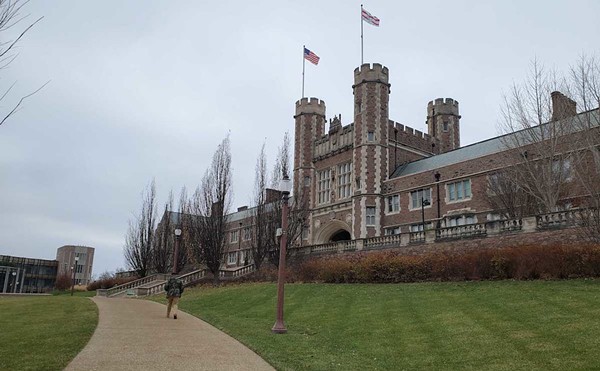Everybody was all excited, and for two dizzying weeks, Gleason processed, enlarged and purified images from the telescope's camera, dreaming all the while about going home for Christmas and announcing that a comet would be named after her.
Alas, Arianna's comet turned out to be merely a faraway galaxy (news her Webster Groves family heard as, "Arianna's discovered a galaxy!"). But she's still blissful about staying up all night looking for near-earth asteroids (NEAs), faraway asteroids and trans-Neptunian objects (TNOs, objects that have crossed the orbit of Neptune).
"We go up the mountain around 5 p.m., wearing really heavy clothes, jeans and layers of sweatshirts," she explains happily. "First you have to focus the telescope and align it, then align all the other electronics so it's ready as soon as the sun goes down." Lights are restricted in Tucson, especially on Kitt Peak, so the night sky's velvety black, "so dark, the stars are just falling on you. The sky's just littered with them."
Gleason's young; even the observatory's many flights of stairs fuel her imagination. "From the ground, you go up two flights to the control room, then one more to where the telescope sits, then crawl up three or so ladders to the platform of the telescope, where our camera is," she relates eagerly. "Before you can start observing, you have to cool down the camera with liquid nitrogen, because if it's warm you get this chromatic aberration; the warmth creates waves in the pictures.
"So we're up on the mountain and we kind of take turns doing passes with the camera, to notice if anything is moving. We take three passes over the same region of space." The changes are infinitesimal, maybe three pixels total, in the three images recorded by the telescope camera. "We look for these TNOs, these really small objects that are very, very far away, which means they don't move much in our image. Then there are the main-belt asteroids; they move quite a bit in our field of view."
That first night's almost-comet was an understandable miss: It was only two years ago that the Hubble Space Telescope revealed the existence of at least 40 billion more galaxies than astronomers had suspected. "The initial pictures are very raw," Gleason explains. "There is a lot of noise in them. When you're doing a pass, you sit in front of the computer and if you see something interesting, you can highlight it with the mouse." But the computer can also catch "something stupid, like diffraction spikes from bright stars." And the calculations are a high-wire act, the slightest misjudgment disastrous. "Earlier this year, there was a big scare -- people from the University of Arizona supposedly found an asteroid and thought it was going to hit the earth, and the media made a big story about it, but they were a little off. Millions of very small meteorites hit the earth every day, cosmic dust," adds Gleason, who watched the recent Leonids meteor shower in the blackness of the desert.
Even better, though, is crawling out the hatch and sitting on the domed top of the observatory. "It's really cold," she says with a smile. "But I don't think I have ever felt such a feeling of peace and pure happiness. It was so wonderful I could taste it. It was like being on top of the world." And then the world moved beneath her. "Nicole had to adjust the dome," she grins. "Every time we find a new area of space, the telescope changes position a little bit, so we have to move the dome. She started spinning it while I was up there, and I kind of had to hold on. It moves very slowly, but it was still exhilarating!"
The Spacewatch director, Dr. Jeff Larson (who's found one or two comets on his own, Gleason notes), has written elaborate computer programs to track TNOs and other bodies. Gleason had to learn, quickly, all these "alpha programs, which have just been born." But Larson had been impressed with her earlier calculations of stellar distances on a project at the University of Missouri-Columbia when she was a junior in high school. "They were pretty good numbers I came up with," she admits, "5-10 percent error, and when you're talking light years, that's pretty good!
"It's called astrometry, measuring the size and trajectory of asteroids," Gleason adds helpfully. "If the previous team has found anything interesting, we do what are called 'recoveries' of their objects, using the 'RA' and the 'dec.'" (That's the right ascension and the declination, the coordinates used to map the cosmos.) "We need to know the date it was found, and the time, and then we are able to find it again. And we also scan new areas of space, hopefully where no one else has looked.continued on next pagecontinued from previous page
"NEAs have been kicked out of their normal orbit," explains Gleason, "and if they are large enough, they could impact the earth and annihilate all life -- like the asteroids that ended the dinosaur age." As for TNOs, they're believed to hail "from the Kuiper Belt on the perimeter of our solar system." It was named for Gerard Peter Kuiper, an astronomer who suggested that a flattened belt of comets circles the sun beyond Neptune's orbit. "They think Pluto is actually a very large Kuiper object," she adds. "It's small and rocky, more like the inner planets, and it's not on the same plane. These TNOs orbit the sun too, but their orbits can be so elliptical that sometimes they can hit planets. The moon has been bombarded; that's why it's so cratered." She's especially interested in TNOs because, "since they're so far away, their composition is the least modified, and it holds clues to the time our galaxy was formed."
Pink-cheeked, with strawberry-blond hair, blue eyes and the inevitable home-from-college blazer, Gleason's excited about her new coffee habit and college life in general. "I love it when everyone is so excited, and there is such a connection between people," she confides. "They want to understand, and it's ... almost beyond words." She even feels that way about the marching band: "In Tucson we get these monsoons, and we'll be out there marching in pouring rain -- I know it sounds crazy, but it's fun, if you all love it together."
Her fascination with astronomy started early. "I'd see other little girls reading Seventeen; I was reading Discover and National Geographic," she shrugs. "By the end of fifth grade, I weaseled out of 'I want to be a baker, I want to be a farmer' and fell in love with astronomy." Her grandfather graduated from MIT and rose to a vice presidency at McDonnell Douglas; on long walks, she used to pester him to show her Venus, show her Jupiter, explain why the planets are all so different, why the moon changes shape, why the constellations shift.
She never felt the cool detachment of the cosmos, but even as a child she "always thought that the earth was very small and very insignificant." Now, what she struggles to comprehend isn't the vastness of the universe, it's the pettiness of so many human concerns: the consuming interest in O.J., the disproportionate fuss over Clinton's peccadillos. "Sometimes people's materialistic values and superficial tendencies are ridiculous," she says politely. "My friends sometimes get on my nerves -- if you're so focused on the way your hair looks and the nail polish you have on and the guys you have kissed, you lose touch with how much can be accomplished. To be able to learn, to want to learn, is an amazing thing."
Outside college, Gleason sees a lot of people who "just don't care. They'd rather sit around and watch TV than read a book about the creation of our solar system. I find it saddening." Ah, but does she understand it? She nods slowly. "It takes effort to want to know."
Are people put off by her intelligence? "I don't know as I'm bright," she replies cheerfully. "My test scores are about average. I'm just very ambitious. And extremely self-critical, sometimes to a point where it's damaging.
"I just feel this passion," she bursts. "All these different planets and elements have come together to make these extraordinary creations. To not figure that out, not try to understand it, is a shame -- because it is the root of our existence. None of us would be here if stars didn't die."
She's not being lyrical: Stars are born, live and die just as we do, and our Earth condensed from a cloud of interstellar gas and dust that collapsed some four-and-a-half billion years ago. "I'm very much interested in the origins of the universe," says Gleason, "why certain elements band together to create such a magnificent planet which yields life, while others have not."
You're tempted to ask that inane stock question, "Do you have a favorite ... planet?" "The moon, actually," she replies. "I'm in love with the moon. I don't think there is any organic or inorganic entity more beautiful." Eventually she'd like to help create a "biosphere," a bubble on the moon where life as we know it could exist. "Right now funds are quite low for anything like that," she notes ruefully. "NASA is not high on the list."
Gleason's ultimate dream is "to become an astronaut, be some sort of mission specialist, do research up in space. I'll settle for nothing else. So it's that or death, I suppose. I'm a very intense person.





